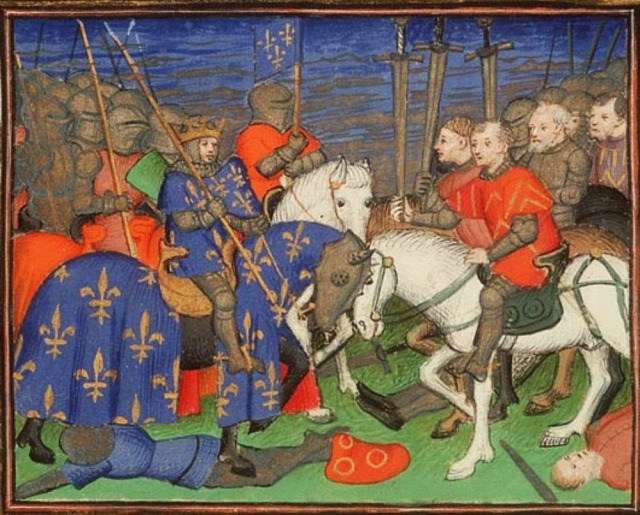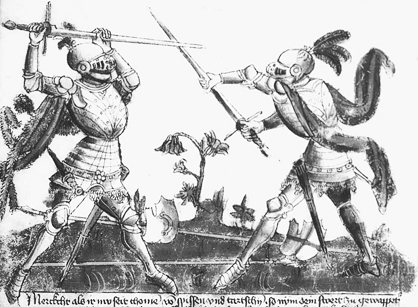Connoisseurs of medieval weapons will instantly recognize the name Ewart Oakeshott. He stood at the forefront of the movement to create accurate replicas of medieval swords and to understand how medieval warriors really fought. Many museums now hold antique blades donated from his private collection. That the stereotype of knights as clumsy oafs bashing away at each other with swords is slowly disappearing owes much to Oakeshott’s work, which included delving into both history and the weapons themselves. These habits come across very strongly in the two works under review here: A Knight in Battle and A Knight and His Armor from Oakeshott’s “Life of the Medieval Knight” series.
A Knight in Battle might be considered an excellent introduction to the study of medieval warfare. The battles were chosen with two things in mind: 1) that they be key battles in particular phases of medieval warfare and 2) that they introduce the reader to famous knights and warriors of medieval times. Saladin, Richard the Lionheart, William Marshall, Prince John, Edward the Longshanks, the Black Prince, and Bayard are all portrayed within these pages. The four battles stretch from 1191 to 1515: the battles of Arsuf , Lincoln, Mauron, and Marignano. The first two battles occur before the Age of Plate, where the knight’s charge was the decisive factor in battle. The Battle of Mauron occurs during the Hundred Years’ War and demonstrates how the longbow changed the nature of warfare. (Curiously, this battle reminds me of how I used to play Heroes of Might and Magic: Quest for the Dragonbone Staff. I never would have guessed that I used the English style of warfare!) The last battle occurs at the time when infantry was rising in importance, knights wore full plate, and firearms began to change the face of warfare. One does wish that Oakeshott had also chosen a battle during the Viking Age (800 – 1066). Other than that, I cannot recommend this work highly enough.
A Knight and His Armor provides an in-depth look at plate armor. It also covers chainmail, but chainmail’s lack of complexity leads the author to spend less time on it. As in the other work, the illustrations are all provided by the author and detail the evolution of plate armor quite well. Each change during the advance of plate armor absorbs the readers attention. I probably spent at least a third of the time it took to read the work contemplating each suit of armor! The medieval personality he brings forth to enliven the book is Kunz Schott, who is famed for his three decades long feud with the city of Nuremberg which ended a few years prior to his death in 1526. The author had the pleasure of examining Schott’s armor–one of the best preserved in Europe–firsthand. Indeed, the main reason Oakeshott’s books on armor and weapons are more interesting than many other scholars is because of his desire to not only read about them but to experience them! My dear readers interested in the armor of medieval times cannot do much better than this work as an introduction.
Well, that adequately describes the above two works. I can recall only a couple of things which irked me about them. The first is the shortness of the volumes, but I suppose if one took the “Life of the Medieval Knight” series as a whole, one would have a very good sized book. Then, there was Oakeshott’s comment that Christians and Muslims would have gotten along were it not for clerics on both sides influencing their governments and peoples to go to war. Despite the respect Christians held for certain Muslims, especially Saladin, and the Muslims’ admiration of Frankish bravery, this remark holds more true of the American Civil War than the Crusades. (Let the pro-slavery and abolitionist zealots on both sides stand in for clerics.) Read about the causes of the Crusades, and you’ll see that the Emperor of Byzantium asking for help in fending off the Seljuk Turks and the Muslims enslaving Christian pilgrims to the Holy Land were the primary motivators for Pope Urban II calling for the First Crusade. The reasons behind the other Crusades become more complicated, but the above factors suffice to prove that not only religious reasons prompted the Crusades. Nevertheless, these two works are excellent, and I hope to read more of this series in the future.


